Experimental Study on the Health Benefits of Garden Landscape
Abstract
1. Introduction
2. Methodology
2.1. Participants and Landscape Images
2.2. Data Collection
2.3. Data Analysis
3. Results
3.1. Cerebral Blood Flow
3.2. Autonomic Nervous Activity
3.3. Psychological Response
4. Discussion
5. Conclusions
Acknowledgments
Conflicts of Interest
References
- United Nations. World Urbanization Prospects: 2014 Revision; United Nations: New York, NY, USA, 2014. [Google Scholar]
- Park, C.M. The quality of life in South Korea. Soc. Indic. Res. 2009, 92, 263–294. [Google Scholar] [CrossRef]
- Danaei, G.; Singh, G.M.; Paciorek, C.J.; Lin, J.K.; Cowan, M.J.; Finucane, M.M.; Farzadfar, F.; Stevens, G.A.; Riley, L.M.; Lu, Y.; et al. The global burden of cardiovascular risk transition: Associations of four metabolic risk factors with national income, urbanization, and Western diet in 1980 and 2008. Circulation 2013, 127, 1493–1502. [Google Scholar] [CrossRef] [PubMed]
- Galea, S.; Uddin, M.; Koenen, K. The urban environment and mental disorders: Epigenetic links. Epigenetics 2011, 6, 400–404. [Google Scholar] [CrossRef]
- Gong, P.; Liang, S.; Carlton, E.J.; Jiang, Q.; Wu, J.; Wang, L.; Remais, J.V. Urbanisation and health in China. Lancet 2012, 379, 843–852. [Google Scholar] [CrossRef]
- Wagner, K.H.; Brath, H. A global view on the development of non communicable diseases. Prev. Med. 2012, 54, S38–S41. [Google Scholar] [CrossRef] [PubMed]
- Li, Q.; Morimoto, K.; Nakadai, A.; Inagaki, H.; Katsumata, M.; Shimizu, T.; Hirata, Y.; Hirata, K.; Suzuki, H.; Miyazaki, Y.; et al. Forest bathing enhances human natural killer activity and expression of anti-cancer proteins. Int. J. Immunopathol. Pharmacol. 2007, 20, 3–8. [Google Scholar] [CrossRef]
- Selhub, E.; Logan, A.C. Your Brain on Nature; John Wiley and Sons: Toronto, ON, Canada, 2012. [Google Scholar]
- Takayama, N.; Korpela, K.; Lee, J.; Morikawa, T.; Tsunetsugu, Y.; Park, B.J.; Li, Q.; Tyrväinen, L.; Miyazaki, Y.; Kagawa, T. Emotional, restorative and vitalizing effects of forest and urban environments at four sites in Japan. Int. J. Environ. Res. Public Health 2014, 11, 7207–7230. [Google Scholar] [CrossRef]
- Lederbogen, F.; Kirsch, P.; Haddad, L.; Streit, F.; Tost, H.; Schuch, P.; Wüst, S.; Pruessner, J.C.; Rietschel, M.; Deuschle, M.; et al. City living and urban upbringing affect neural social stress processing in humans. Nature 2011, 474, 498–501. [Google Scholar] [CrossRef] [PubMed]
- Lee, J.; Park, B.J.; Tsunetsugu, Y.; Ohira, T.; Kagawa, T.; Miyazaki, Y. Effect of forest bathing on physiological and psychological responses in young Japanese male subjects. Public Health 2011, 125, 93–100. [Google Scholar] [CrossRef]
- Lee, J.; Tsunetsugu, Y.; Takayama, N.; Park, B.J.; Li, Q.; Song, C.; Komatsu, M.; Ikei, H.; Tyrväinen, L.; Kagawa, T.; et al. Influence of forest therapy on cardiovascular relaxation in young adults. Evid.-Based Complement. Altern. Med. 2014, 2014, 834360. [Google Scholar] [CrossRef] [PubMed]
- Park, B.J.; Tsunetsugu, Y.; Kasetani, T.; Hirano, H.; Kagawa, T.; Sato, M.; Miyazaki, Y. Physiological effects of Shinrin-yoku (taking in the atmosphere of the forest)—Using salivary cortisol and cerebral activity as indicators. J. Physiol. Anthropol. 2007, 26, 123–128. [Google Scholar] [CrossRef] [PubMed]
- Thompson, C.W.; Roe, J.; Aspinall, P.; Mitchell, R.; Clow, A.; Miller, D. More green space is linked to less stress in deprived communities: Evidence from salivary cortisol patterns. Landsc. Urban Plan. 2012, 105, 221–229. [Google Scholar] [CrossRef]
- Tsunetsugu, Y.; Lee, J.; Park, B.J.; Tyrväinen, L.; Kagawa, T.; Miyazaki, Y. Physiological and psychological effects of viewing urban forest landscapes assessed by multiple measurements. Landsc. Urban Plan. 2013, 113, 90–93. [Google Scholar] [CrossRef]
- Mitchell, R.; Popham, F. Effect of exposure to natural environment on health inequalities: An observational population study. Lancet 2008, 372, 1655–1660. [Google Scholar] [CrossRef]
- Takano, T.; Nakamura, K.; Watanabe, M. Urban residential environments and senior citizens’ longevity in megacity areas: The importance of walkable green spaces. J. Epidemiol. Community Health 2002, 56, 913–918. [Google Scholar] [CrossRef] [PubMed]
- Korea Forest Service. Forestry Culture and Recreation Act; Ministry of Government Legislation: Daejeon, Korea, 2016.
- Velarde, M.D.; Fry, G.; Tveit, M. Health effects of viewing landscapes—Landscape types in environmental psychology. Urban For. Urban Green 2007, 6, 199–212. [Google Scholar] [CrossRef]
- Ulrich, R.S. View through a window may influence recovery from surgery. Science 1984, 224, 420–421. [Google Scholar] [CrossRef] [PubMed]
- Abraham, A.; Sommerhalder, K.; Abel, T. Landscape and well-being: A scoping study on the health-promoting impact of outdoor environments. Int. J. Public Health 2010, 55, 59–69. [Google Scholar] [CrossRef] [PubMed]
- Bowler, D.E.; Buyung-Ali, L.M.; Knight, T.M.; Pullin, A.S. A systematic review of evidence for the added benefits to health of exposure to natural environments. BMC Public Health 2010, 10, 456. [Google Scholar] [CrossRef] [PubMed]
- Tzoulas, K.; Korpela, K.; Yli-Pelkonen, V.; Kaźmierczak, A.; Niemela, J.; Jamese, P. Promoting ecosystem and human health in urban areas using Green Infrastructure: A literature review. Landsc. Urban Plan. 2007, 81, 167–178. [Google Scholar] [CrossRef]
- Armstrong, D. A survey of community gardens in upstate New York: Implications for health promotion and community development. Health Place 2000, 6, 319–327. [Google Scholar] [CrossRef]
- Hartig, T.; Marcus, C.C. Healing gardens-places for nature in health care. Lancet 2006, 368, 536–537. [Google Scholar] [CrossRef]
- Kingsley, J.Y.; Townsend, M.; Henderson-Wilson, C. Cultivating health and wellbeing: Members’ perceptions of the health benefits of a Port Melbourne community garden. Leisure Stud. 2009, 28, 207–219. [Google Scholar] [CrossRef]
- Marcus, C.C. Healing gardens in hospitals. Interdiscip. Des. Res. 2007, 1, 1–27. [Google Scholar]
- Said, I. Therapeutic effects of garden: Preference of ill children towards garden over ward in Malaysian hospital environment. J. Teknol. 2003, 38, 55–68. [Google Scholar] [CrossRef]
- Sherman, S.A.; Varni, J.W.; Ulrich, R.S.; Malcarne, V.L. Post-occupancy evaluation of healing gardens in a pediatric cancer center. Landsc. Urban Plan. 2005, 73, 167–183. [Google Scholar] [CrossRef]
- Ulrich, R.S. Effects of gardens on health outcomes: Theory and research. In Healing Gardens: Therapeutic Benefits and Design Recommendations; Cooper-Marcus, C., Barnes, M., Eds.; John Wiley & Sons Inc.: New York, NY, USA, 1999; pp. 27–85. [Google Scholar]
- Whitehouse, S.; Varni, J.W.; Seid, M.; Cooper-Marcus, C.; Ensberg, M.J.; Jacobs, J.R.; Mehlenbeck, R.S. Evaluating a children’s hospital garden environment: Utilization and consumer satisfaction. J. Environ. Psychol. 2001, 21, 301–314. [Google Scholar] [CrossRef]
- Abendroth, S.; Kowarik, I.; Müller, N.; von der Lippe, M. The green colonial heritage: Woody plants in parks of Bandung, Indonesia. Landsc. Urban Plan. 2012, 106, 12–22. [Google Scholar] [CrossRef]
- Feng, S.; Xu, K. The elaboration of five “Perspectives”: Application to traditional landscape idea in modern landscape design. Appl. Mech. Mater. 2012, 226–228, 2458–2461. [Google Scholar] [CrossRef]
- Hoshi, Y.; Kobayashi, N.; Tamura, M. Interpretation of near infrared spectroscopy signals: A study with a newly developed perfused rat brain model. J. Appl. Physiol. 2001, 90, 1657–1662. [Google Scholar] [PubMed]
- Igarashi, M.; Yamamoto, T.; Lee, J.; Song, C.; Ikei, H.; Miyazaki, Y. Effects of stimulation by three-dimensional natural images on prefrontal cortex and autonomic nerve activity: A comparison with stimulation using two-dimensional images. Cogn. Process. 2014, 15, 551–556. [Google Scholar] [CrossRef] [PubMed]
- McNair, D.M.; Lorr, M.; Droppleman, L.F. Revised Manual for the Profile of Mood States; Educational and Industrial Testing Service: San Diego, CA, USA, 1992. [Google Scholar]
- Osgood, C.E.; Suci, G.J.; Tannenbaum, P.H. The Measurement of Meaning; University of Illinois Press: Urbana, IL, USA, 1957. [Google Scholar]
- Spielberger, C.D. Manual for the State-Trait Anxiety Inventory; Consulting Psychologists Press: Palo Alto, CA, USA, 1983. [Google Scholar]
- Park, B.J.; Tsunetsugu, Y.; Kasetani, T.; Kagawa, T.; Miyazaki, Y. The physiological effects of shinrin-yoku (taking in the forest atmosphere or forest bathing): Evidence from field experiments in 24 forests across Japan. Environ. Health Prev. Med. 2010, 15, 18–26. [Google Scholar] [CrossRef] [PubMed]
- Lee, J.; Park, B.J.; Ohira, T.; Kagawa, T.; Miyazaki, Y. Acute effects of exposure to a traditional rural environment on urban dwellers: A crossover field study in terraced farmland. Int. J. Environ. Res. Public Health 2015, 12, 1874–1893. [Google Scholar] [CrossRef] [PubMed]
- Song, C.; Ikei, H.; Igarashi, M.; Takagaki, M.; Miyazaki, Y. Physiological and psychological effects of a walk in urban parks in fall. Int. J. Environ. Res. Public Health 2015, 12, 14216–14228. [Google Scholar] [CrossRef] [PubMed]
- Kuo, F.E. Coping with poverty: Impacts of environment and attention in the inner city. Environ. Behav. 2001, 33, 5–34. [Google Scholar] [CrossRef]
- Song, C.R.; Joung, D.; Ikei, H.; Miyazaki, Y. Physiological and psychological effects of walking on young males in urban parks in winter. J. Physiol. Anthropol. 2013, 32, 18. [Google Scholar] [CrossRef] [PubMed]
- Lyons, E. Demographic correlates of landscape preference. Environ. Behav. 1983, 15, 487–511. [Google Scholar] [CrossRef]
- Jiang, B.; Chang, C.Y.; Sullivan, W.C. A dose of nature: Tree cover, stress reduction, and gender differences. Landsc. Urban Plan. 2014, 132, 26–36. [Google Scholar] [CrossRef]
- Miyazaki, Y.; Tsunetsugu, Y. A tentative proposal on physiological polymorphism and its experimental approaches. J. Physiol. Anthropol. Appl. Hum. Sci. 2005, 24, 297–300. [Google Scholar] [CrossRef]
- Song, C.; Ikei, H.; Miyazaki, Y. Elucidation of a physiological adjustment effect in a forest environment: A pilot study. Int. J. Environ. Res. Public Health 2015, 12, 4247–4255. [Google Scholar] [CrossRef] [PubMed]
- Pretty, J.; Peacock, J.; Sellens, M.; Griffin, M. The mental and physical health outcomes of green exercise. Int. J. Environ. Health Res. 2005, 15, 319–337. [Google Scholar] [CrossRef] [PubMed]
- Africa, J.; Logan, A.; Mitchell, R.; Korpela, K.; Allen, D.; Tyrväinen, L.; Nisbet, E.; Li, Q.; Tsunetsugu, Y.; Miyazaki, Y.; et al. The Natural Environment Initiative: Illustrative Review and Workshop Statement; Center for Health and the Global Environment at the Harvard School of Public Health: Boston, MA, USA, 2014. [Google Scholar]
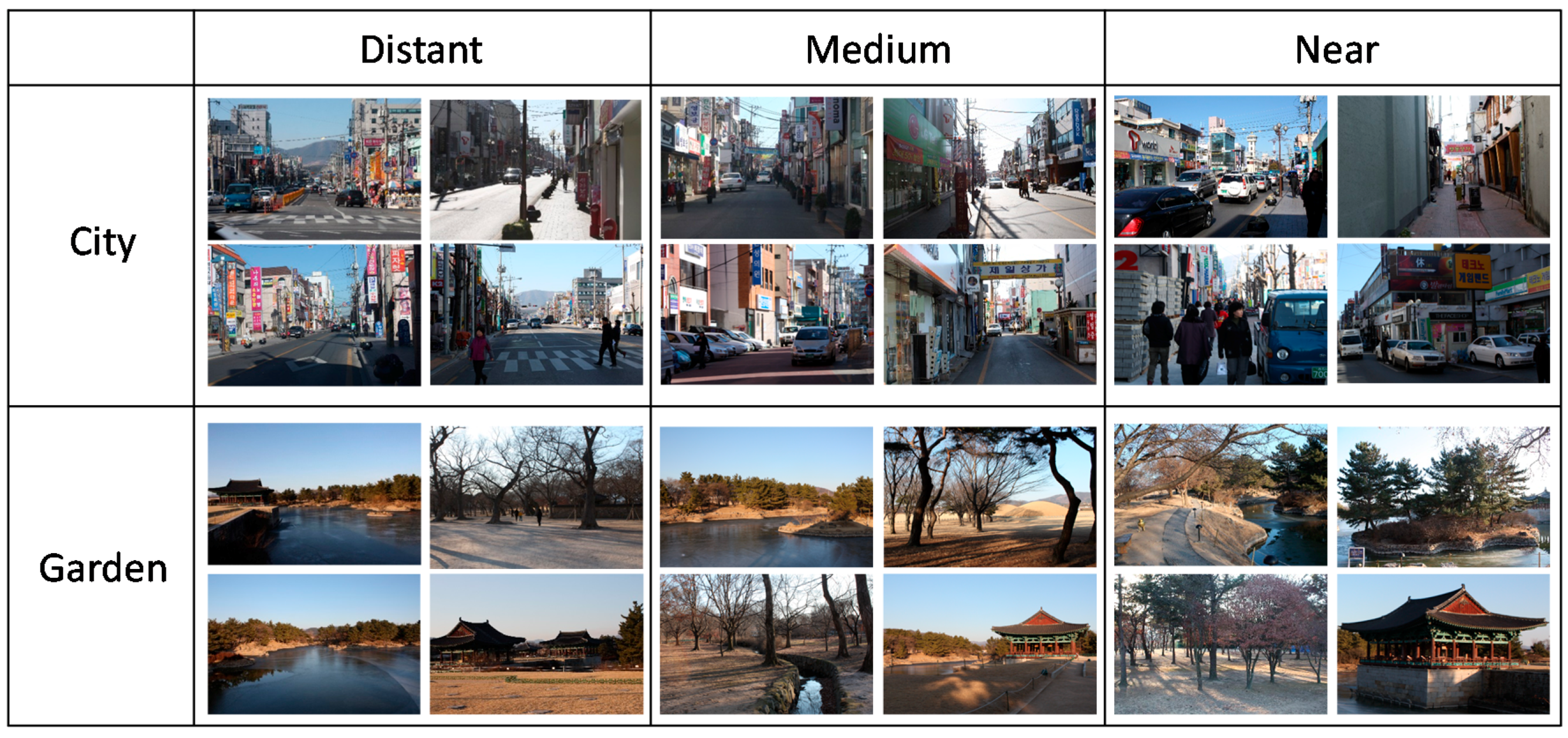
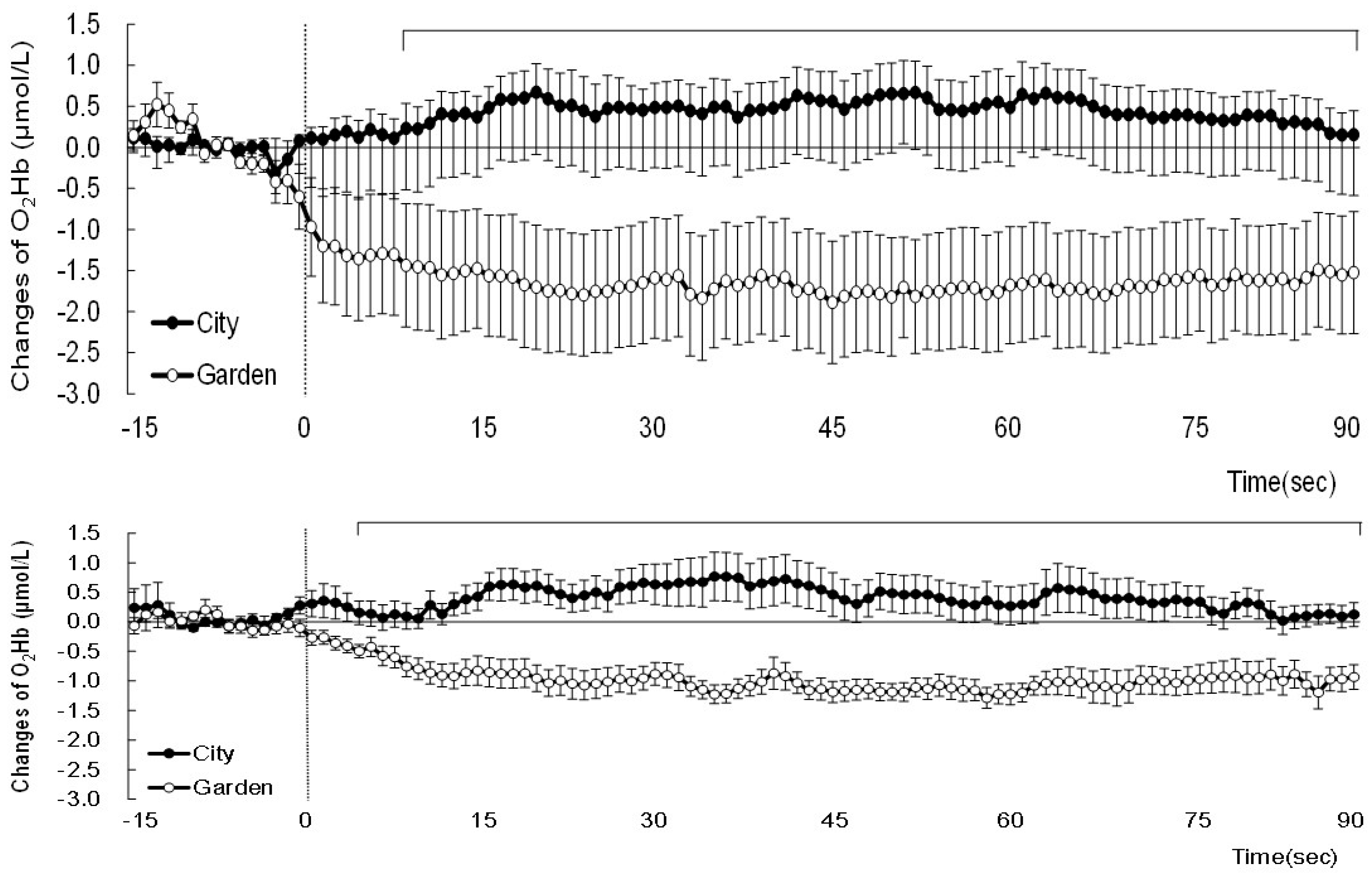
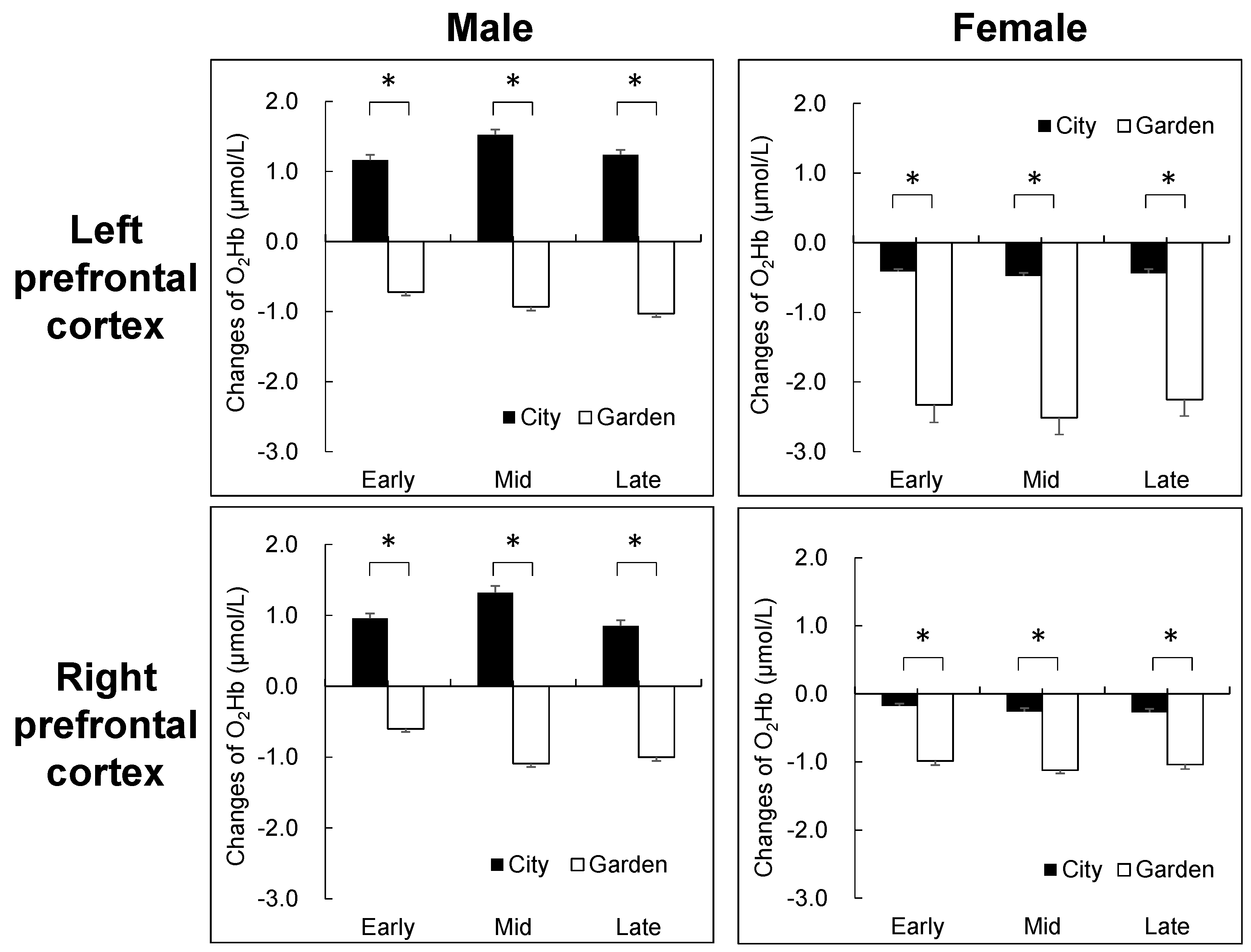

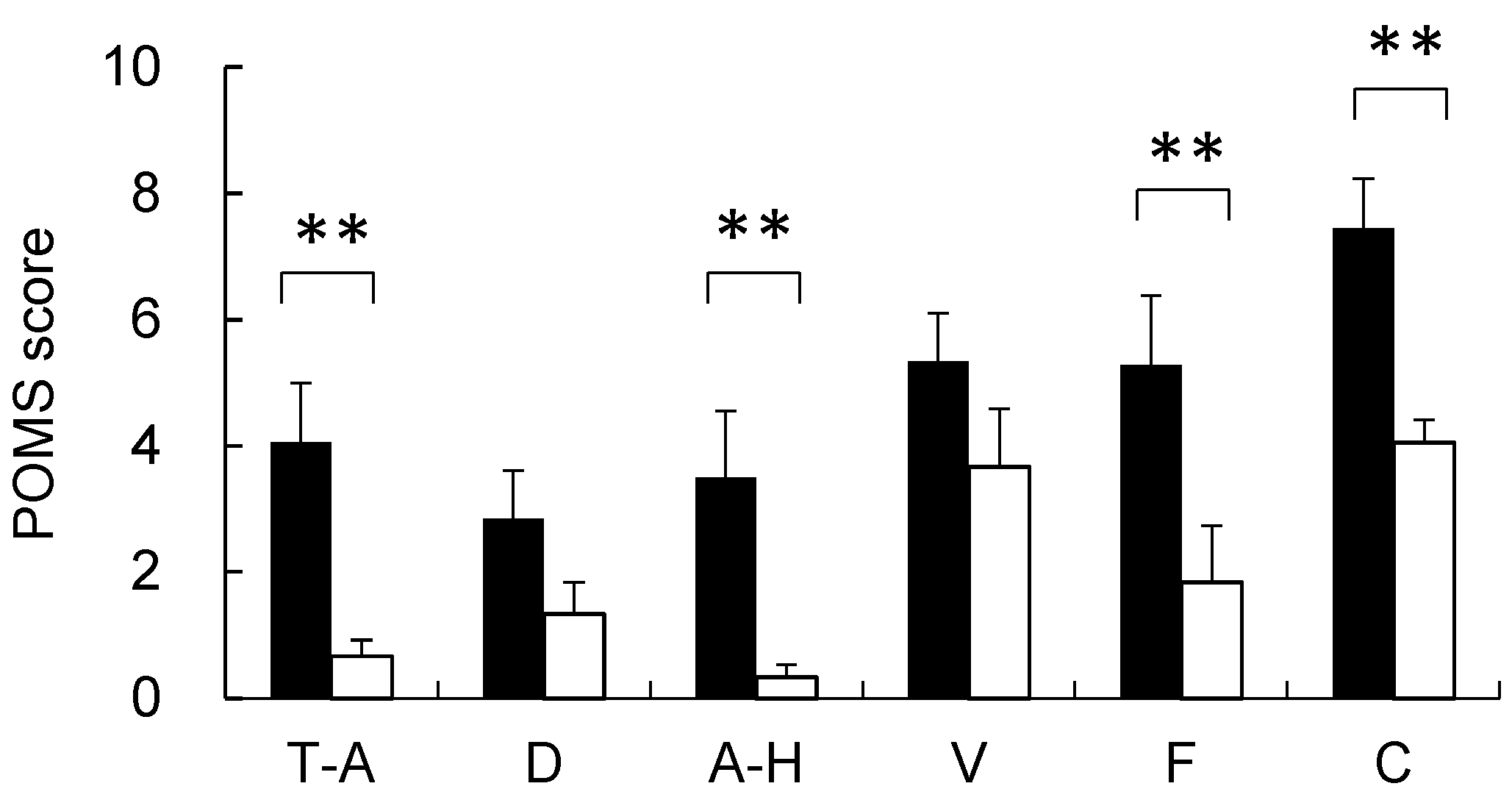
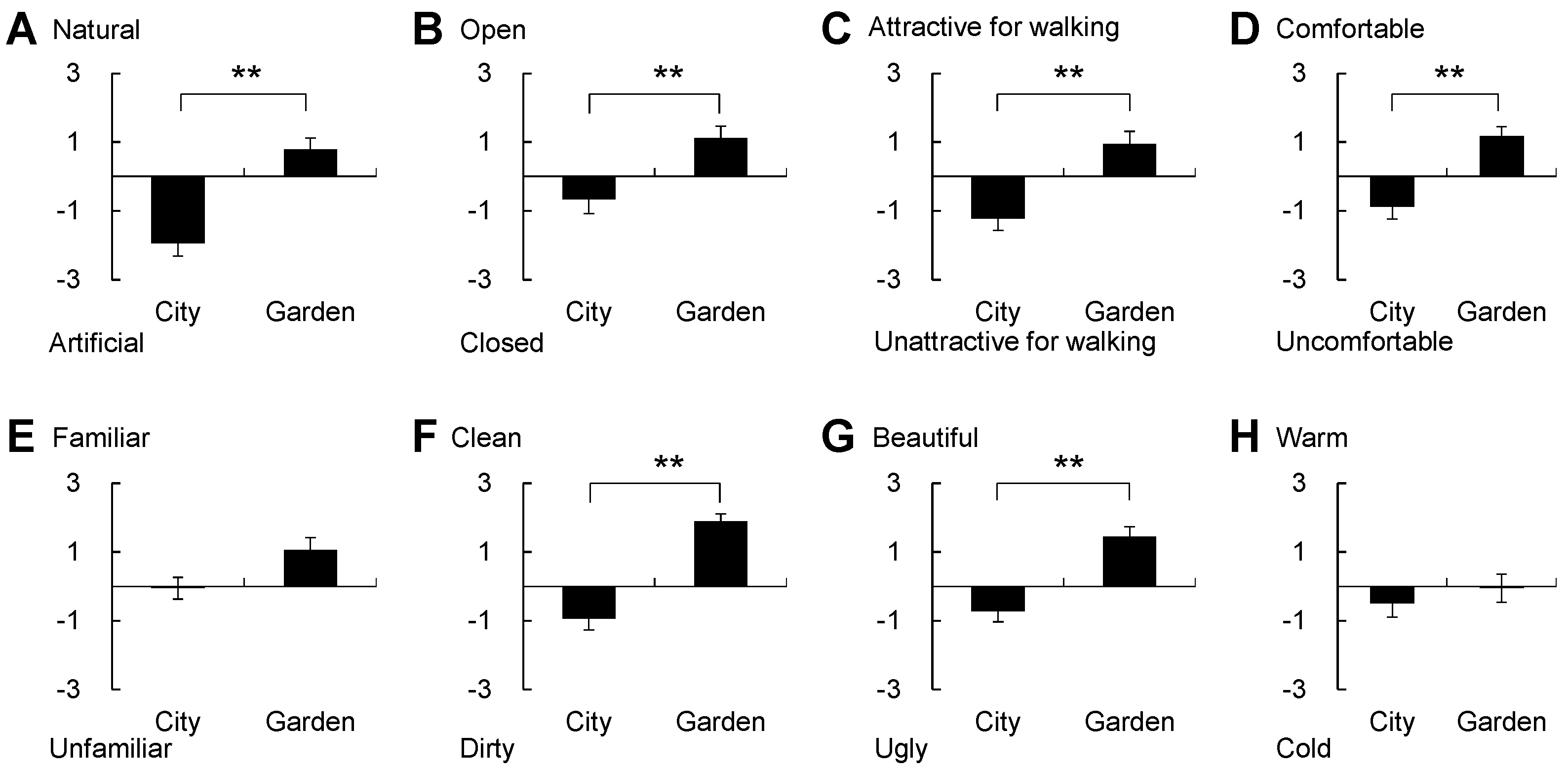
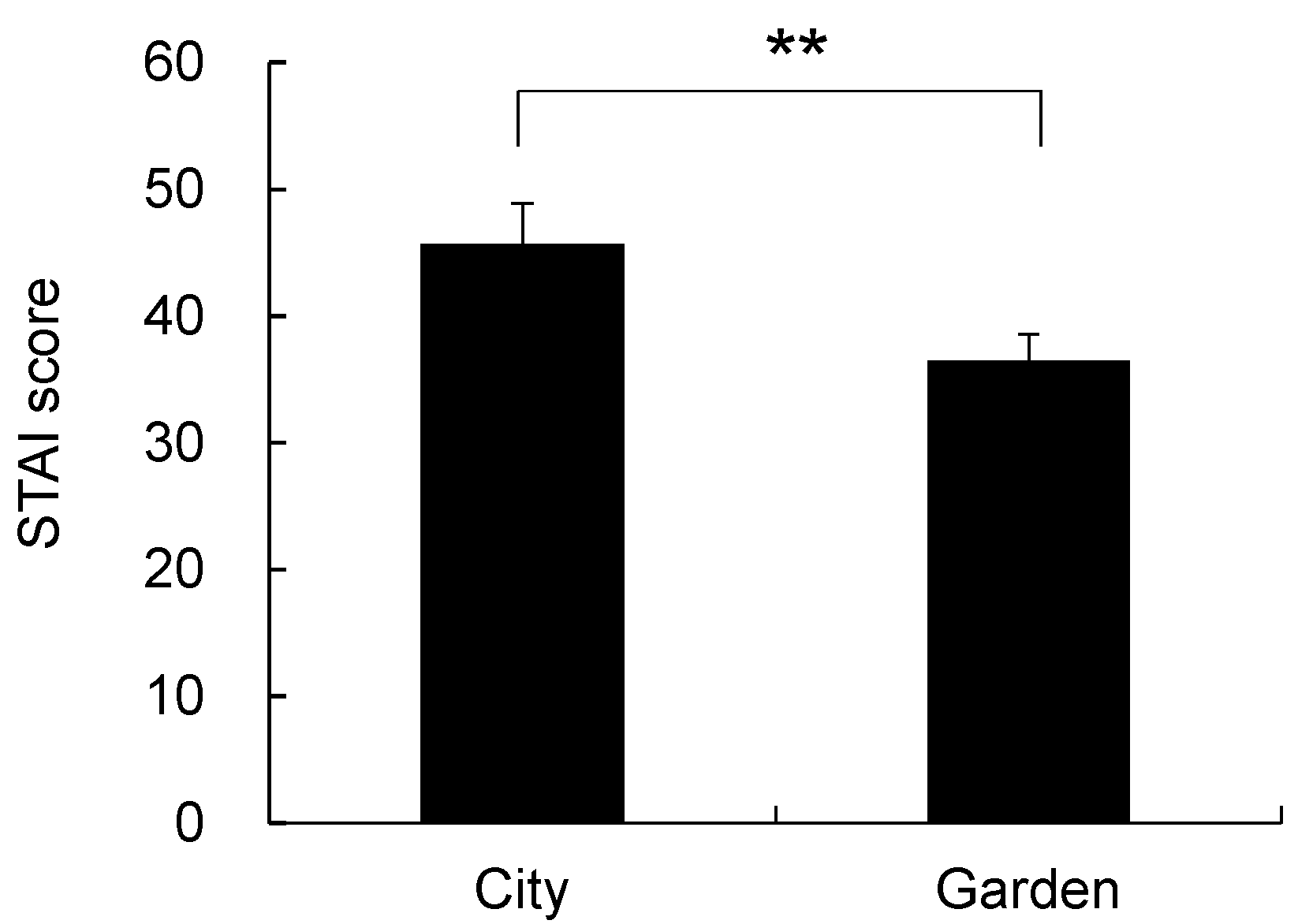
| Parameters | Total a | Male a | Female a | |||
|---|---|---|---|---|---|---|
| Mean | SE | Mean | SE | Mean | SE | |
| Age | 26.7 | 0.7 | 27.8 | 1.1 | 25.6 | 0.8 |
| Height (cm) | 167.4 | 1.3 | 171.2 | 1.0 | 163.7 | 1.5 |
| Weight (kg) | 57.7 | 1.7 | 62.8 | 1.4 | 52.6 | 1.9 |
| BMI (kg/m2) b | 20.5 | 0.4 | 21.4 | 0.5 | 19.6 | 0.5 |
| Pulse rate (bpm) | 67.6 | 1.7 | 69.1 | 3.1 | 66.2 | 1.5 |
| SBP (mmHg) b | 107.9 | 2.7 | 115.8 | 3.4 | 100.1 | 1.9 |
| DBP (mmHg) b | 64.4 | 1.9 | 66.0 | 3.3 | 62.8 | 2.0 |
© 2017 by the author. Licensee MDPI, Basel, Switzerland. This article is an open access article distributed under the terms and conditions of the Creative Commons Attribution (CC BY) license (http://creativecommons.org/licenses/by/4.0/).
Share and Cite
Lee, J. Experimental Study on the Health Benefits of Garden Landscape. Int. J. Environ. Res. Public Health 2017, 14, 829. https://doi.org/10.3390/ijerph14070829
Lee J. Experimental Study on the Health Benefits of Garden Landscape. International Journal of Environmental Research and Public Health. 2017; 14(7):829. https://doi.org/10.3390/ijerph14070829
Chicago/Turabian StyleLee, Juyoung. 2017. "Experimental Study on the Health Benefits of Garden Landscape" International Journal of Environmental Research and Public Health 14, no. 7: 829. https://doi.org/10.3390/ijerph14070829
APA StyleLee, J. (2017). Experimental Study on the Health Benefits of Garden Landscape. International Journal of Environmental Research and Public Health, 14(7), 829. https://doi.org/10.3390/ijerph14070829





